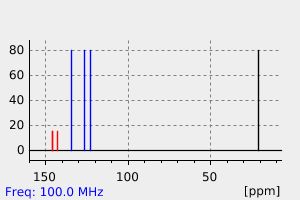4-硝基甲苯-2-磺酸 | 121-03-9
-
物化性质
-
计算性质
-
ADMET
-
安全信息
-
SDS
-
制备方法与用途
-
上下游信息
-
文献信息
-
表征谱图
-
同类化合物
-
相关功能分类
-
相关结构分类
物化性质
-
熔点:135°C
-
沸点:500°C (rough estimate)
-
密度:1.6040 (rough estimate)
-
溶解度:甲醇(微溶)、水(微溶)
-
颜色/状态:PRISMS OR PLATES FROM WATER
-
稳定性/保质期:
计算性质
-
辛醇/水分配系数(LogP):0.9
-
重原子数:14
-
可旋转键数:1
-
环数:1.0
-
sp3杂化的碳原子比例:0.142
-
拓扑面积:109
-
氢给体数:1
-
氢受体数:5
安全信息
-
危险等级:8
-
危险品标志:Xn
-
安全说明:S26,S36/37/39
-
危险类别码:R34
-
危险品运输编号:3261
-
RTECS号:DB7175000
-
海关编码:2904909090
-
包装等级:III
-
危险类别:8
-
危险性防范说明:P234,P260,P264,P280,P301+P330+P331+P310,P303+P361+P353+P310+P363,P304+P340+P310,P305+P351+P338+P310,P390,P405,P406,P501
-
危险性描述:H290,H314
-
储存条件:室温且干燥
SDS
模块 1. 化学品
产品名称: 4-Nitrotoluene-2-sulfonic Acid Hydrate
修改号码: 5
模块 2. 危险性概述
GHS分类
物理性危害
金属腐蚀性 第1级
健康危害
急性毒性(经口) 第5级
皮肤腐蚀/刺激 1C类
严重损伤/刺激眼睛 第1级
环境危害 未分类
GHS标签元素
图标或危害标志
信号词 危险
危险描述 可能腐蚀金属
吞咽可能有害。
造成严重的皮肤灼伤和眼损伤
防范说明
[预防] 只可存放于原用的容器内。
切勿吸入。
处理后要彻底清洗双手。
穿戴防护手套/护目镜/防护面具。
[急救措施] 吸入:将受害者移到新鲜空气处,在呼吸舒适的地方保持休息。
食入:漱口。切勿催吐。
眼睛接触:用水小心清洗几分钟。如果方便,易操作,摘除隐形眼镜。继续冲洗。
皮肤接触:立即去除/脱掉所有被污染的衣物。用水清洗皮肤/淋浴。
被污染的衣物清洗后方可重新使用。
立即呼叫解毒中心/医生。
吸收溢出物,防止材料被损坏。
[储存] 存放处须加锁。
4-硝基甲苯-2-磺酸水合物 修改号码:5
模块 2. 危险性概述
[废弃处置] 根据当地政府规定把物品/容器交与工业废弃处理机构。
模块 3. 成分/组成信息
单一物质/混和物 单一物质
化学名(中文名): 4-硝基甲苯-2-磺酸水合物
百分比: >95.0%(T)
CAS编码: 121-03-9
分子式:
C7H7NO5S·xH2O
模块 4. 急救措施
吸入: 将受害者移到新鲜空气处,保持呼吸通畅,休息。立即呼叫解毒中心/医生。
皮肤接触: 立即去除/脱掉所有被污染的衣物。用大量肥皂和水轻轻洗。
立即呼叫解毒中心/医生。
眼睛接触: 用水小心清洗几分钟。如果方便,易操作,摘除隐形眼镜。继续清洗。
立即呼叫解毒中心/医生。
食入: 立即呼叫解毒中心/医生。漱口。切勿引吐。
紧急救助者的防护: 救援者需要穿戴个人防护用品,比如橡胶手套和气密性护目镜。
模块 5. 消防措施
合适的灭火剂: 干粉,泡沫,雾状水,二氧化碳
特殊危险性: 小心,燃烧或高温下可能分解产生毒烟。
特定方法: 从上风处灭火,根据周围环境选择合适的灭火方法。
非相关人员应该撤离至安全地方。
周围一旦着火:如果安全,移去可移动容器。
消防员的特殊防护用具: 灭火时,一定要穿戴个人防护用品。
模块 6. 泄漏应急处理
个人防护措施,防护用具, 使用特殊的个人防护用品(针对有毒颗粒的P3过滤式空气呼吸器)。远离溢出物/泄露
紧急措施: 处并处在上风处。
泄露区应该用安全带等圈起来,控制非相关人员进入。
环保措施: 防止进入下水道。
控制和清洗的方法和材料: 清扫收集粉尘,封入密闭容器。注意切勿分散。附着物或收集物应该立即根据合适的
法律法规处置。
模块 7. 操作处置与储存
处理
技术措施: 在通风良好处进行处理。穿戴合适的防护用具。防止粉尘扩散。处理后彻底清洗双手
和脸。
注意事项: 如果可能,使用封闭系统。如果粉尘或浮质产生,使用局部排气。
操作处置注意事项: 避免接触皮肤、眼睛和衣物。
使用耐腐蚀设备。
贮存
储存条件: 保持容器密闭。存放于凉爽、阴暗处。
存放处须加锁。
远离不相容的材料比如氧化剂存放。
包装材料: 依据法律。只可存放在原用的容器內。
模块 8. 接触控制和个体防护
工程控制: 尽可能安装封闭体系或局部排风系统。同时安装淋浴器和洗眼器。
4-硝基甲苯-2-磺酸水合物 修改号码:5
模块 8. 接触控制和个体防护
个人防护用品
呼吸系统防护: 防尘面具,自携式呼吸器(SCBA),供气呼吸器等。使用通过政府标准的呼吸器。依
据当地和政府法规。
手部防护: 防渗手套。
眼睛防护: 护目镜。如果情况需要,佩戴面具。
皮肤和身体防护: 防渗防护服。如果情况需要,穿戴防护靴。
模块 9. 理化特性
固体
外形(20°C):
外观: 晶体-粉末
颜色: 白色-深黄红色
气味: 无资料
pH: 无数据资料
熔点:
135°C
沸点/沸程 无资料
闪点: 无资料
爆炸特性
爆炸下限: 无资料
爆炸上限: 无资料
蒸气压: 0.8Pa/20°C
密度: 无资料
溶解度:
[水] 溶于
[其他溶剂]
溶于: 醚, 酒精, 氯仿
模块 10. 稳定性和反应性
化学稳定性: 一般情况下稳定。
危险反应的可能性: 未报道特殊反应性。
须避免接触的物质 氧化剂
危险的分解产物: 一氧化碳, 二氧化碳, 氮氧化物 (NOx), 硫氧化物
模块 11. 毒理学信息
急性毒性: orl-rat LD50:3710 mg/kg
对皮肤腐蚀或刺激: skn-rbt 20 mg/24H MOD
对眼睛严重损害或刺激: eye-rbt 2 mg/24H SEV
生殖细胞变异原性: 无资料
致癌性:
IARC = 无资料
NTP = 无资料
生殖毒性: 无资料
RTECS 号码: DB7175000
模块 12. 生态学信息
生态毒性:
鱼类: 48h LC50:326 mg/L (Oryzias latipes)
96h LC50:>100 mg/L (Oryzias latipes)
甲壳类: 48h EC50:130 mg/L (Daphnia magna)
藻类: 72h EC50:90 mg/L (SElenastrum capricornutum)
4-硝基甲苯-2-磺酸水合物 修改号码:5
模块 12. 生态学信息
残留性 / 降解性: 3 % (by BOD), 0 % (by HPLC), 0 % (by TOC)
潜在生物累积 (BCF): <0.4 (conc. 0.5 mg/L), <4.1 (conc. 0.05 mg/L)
土壤中移动性
log水分配系数: 无资料
土壤吸收系数 (Koc): 无资料
亨利定律 无资料
constaNT(PaM3/MOl):
模块 13. 废弃处置
如果可能,回收处理。请咨询当地管理部门。建议在可燃溶剂中溶解混合,在装有后燃和洗涤装置的化学焚烧炉中
焚烧。废弃处置时请遵守国家、地区和当地的所有法规。
模块 14. 运输信息
联合国分类: 第8类 腐蚀品
UN编号: 3261
正式运输名称: 腐蚀性固体, 酸性的, 有机的, 不另作详细说明
包装等级: III
模块 15. 法规信息
《危险化学品安全管理条例》(2002年1月26日国务院发布,2011年2月16日修订): 针对危险化学品的安全使用、
生产、储存、运输、装卸等方面均作了相应的规定。
模块16 - 其他信息
N/A
制备方法与用途
4-硝基甲苯-2-磺酸自缩聚染料根据缩聚程度可以分为从黄色至红色的多种染料。其中应用最广泛的是直接黄11,这是一种强效黄色染料,特别适用于纤维和皮革等材料的染色。
化学性质板状结晶体(通过水重结晶获得),能够溶解于乙醇、乙醚、氯仿中。
用途该物质用作二苯乙烯系直接染料的中间体,并且是荧光增白剂和染料中间体的重要组成部分。
生产方法由对硝基甲苯经过磺化反应制得。具体步骤为:将熔融的对硝基甲苯加入搪玻璃反应锅内,缓慢滴入20%发烟硫酸980kg,控制温度不超过90℃。加完后升温至105-110℃并保温1小时。反应完成后冷却至70℃,用冷水稀释并在低于100℃的条件下搅拌30分钟。冷却至25℃后调整酸度并进行过滤,滤饼即为2-甲基-5-硝基苯磺酸。
上下游信息
-
上游原料
中文名称 英文名称 CAS号 化学式 分子量 5,5’-二硝基二苯乙烯-2,2’-二磺酸 4,4'-dinitrostilbene 2,2'-disulfonic acid 128-42-7 C14H10N2O10S2 430.373 2-甲基-5-硝基苯磺酰氯 2-methyl-5-nitrobenzene-1-sulfonyl chloride 121-02-8 C7H6ClNO4S 235.648 2-甲基苯磺酸 o-toluenesulfonic acid 88-20-0 C7H8O3S 172.205 -
下游产品
中文名称 英文名称 CAS号 化学式 分子量 —— 2-Bromomethyl-5-nitro-benzenesulfonic Acid —— C7H6BrNO5S 296.098 —— 4-nitrobenzaldehyde-2-sulphonic acid 43099-64-5 C7H5NO6S 231.186 5,5’-二硝基二苯乙烯-2,2’-二磺酸 4,4'-dinitrostilbene 2,2'-disulfonic acid 128-42-7 C14H10N2O10S2 430.373 —— 4,4'-dinitrobibenzyl-2,2'-disulfonic acid 6404-60-0 C14H12N2O10S2 432.389 2,4-二硝基甲苯-6-磺酸 2,4-dinitrotoluene-6-sulfonic acid 133-62-0 C7H6N2O7S 262.2 4-硝基-2-磺基苯甲酸 4-nitro-2-sulfobenzoic acid 22952-26-7 C7H5NO7S 247.185 4-氨基甲苯-2-磺酸 4-amino-toluene-2-sulfonic acid 118-88-7 C7H9NO3S 187.219 —— 5-amino-2-formyl-benzenesulfonic acid 69851-86-1 C7H7NO4S 201.203 4,4'-二氨基二苯乙烯-2,2'-二磺酸 4,4'-diaminostilbene-2,2'-disulfonic acid 81-11-8 C14H14N2O6S2 370.407 —— trans-4,4'-diaminostilbene-2,2'-disulfonic acid 28096-93-7 C14H14N2O6S2 370.407 4,4-二氨基联苄-2,2-二磺酸 4,4'-diaminodiphenyl-2,2'-disulfonic acid 5136-34-5 C14H16N2O6S2 372.423 4-氨基-2-磺基苯甲酸 4-amino-2-sulfobenzoic acid 527-76-4 C7H7NO5S 217.202 - 1
- 2
反应信息
-
作为反应物:描述:参考文献:名称:[EN] MAYTANSINOID-BASED DRUG DELIVERY SYSTEMS
[FR] SYSTÈMES D'ADMINISTRATION DE MÉDICAMENTS À BASE DE MAYTANSINOÏDES摘要:目前的主题提供了结合白蛋白的前药、马替南素类化合物及其用途。公开号:WO2019108975A1 -
作为产物:参考文献:名称:Modified Methods for the Synthesis of Triazinyl Fluorescent Brightener Intermediates摘要:描述了高产率生产三嗪基荧光增白剂中间体的方法。该方法包括简化制备4-硝基-2-甲苯磺酸的工作步骤,以及在制备4,4'-二硝基芪-2,2'-二磺酸时使用二甘醇代替水。DOI:10.3390/80300318
-
作为试剂:描述:3,5-二硝基苯甲醇 在 偶氮二甲酸二异丙酯 、 4-硝基甲苯-2-磺酸 、 三苯基膦 、 肼 作用下, 以 四氢呋喃 为溶剂, 反应 50.0h, 生成 3,5-dinitrobenzylamine参考文献:名称:Fluorescent markers and use thereof for labeling specific protein targets摘要:本文披露了一种新颖的荧光标记物,其中X和Y可以独立或一起缺失,也可以分别选择自R和R1,R和R1可以分别选择自H和烷基;Ar为苯基或杂环芳基;L可以是缺失或从以下组中选择的间隔物,该组包括—NH—;—(CH2)nNH—;—NHSO2—;—(CH2)nNHCO—;-(环烷基)NHCO—;—(CH2)nNHSO2—;-(环烷基)NHSO2—;—CONH(CH2)nNHCO—;—CONH(环烷基)NHCO—;—NHCO(CH2)nNHCO—;—NHCO(环烷基)NHCO—;—(CH2)nSO2NH—;-(环烷基)SO2NH—;—(CH2)nNHCSNH—;-(环烷基)NHCSNH—;—CR═CR1—;—C≡C—;—(CH2)nN═CH—;-(环烷基)N═CH—;—N═CH(CH2)—;—N═CH(环烷基)-;n为1到5的整数;F为从荧光素、罗丹明、苏丹、亚甲基蓝、藏红、香豆素、甲氧基香豆素、丹磺酰基、BODIPY和BODIPY衍生物组中选择的荧光团;其中X、Y和L可以分别位于1,3,5;1,2,3;1,3,4或3,4,5配置中。公开号:US08835641B2
文献信息
-
[EN] ALBUMIN-BINDING PRODRUGS OF AURISTATIN E DERIVATIVES<br/>[FR] PROMÉDICAMENTS SE LIANT À L'ALBUMINE DE DÉRIVÉS D'AURISTATINE E
-
Facile, mild and convenient preparation and characterization of some novel Schiff base ligands from synthetic diamines and salicylaldehyde作者:H. Naeimi、A. HeidarnezhadDOI:10.4314/bcse.v29i1.10日期:——Some novel Schiff base ligands have been prepared through condensation of salicylaldehyde with synthetic various primary diamines under mild reaction conditions. The used aromatic diamines were synthesized in good yields starting from low-cost commercially available materials. In these reactions, the Schiff base products have been afforded with excellent yields and appropriate reaction times. The structure
-
[EN] AZO DYES<br/>[FR] COLORANTS AZOÏQUES申请人:KEMIRA OYJ公开号:WO2012072634A1公开(公告)日:2012-06-07The present invention relates to new azo dyes, a process for their preparation, and their use for dyeing or printing fibrous materials, to produce materials with brownish shades.本发明涉及新的偶氮染料,其制备过程,以及它们用于染色或印花纤维材料以产生棕色调材料的用途。
-
一种二苯乙烯型化合物及其合成方法与应用
-
Effect of target processing on CoCrPtTa thin-film media作者:S. D. Harkness、W. Lewis、M. Bartholomeusz、M. TsaiDOI:10.1557/jmr.2000.0401日期:2000.12
The ensuing paper summarizes an investigation on the effect of target microstructural morphology on resultant sputter deposited media magnetic performance. Significant differences in media magnetic coercivity were obtained from Co–Cr–Pt–Ta targets possessing the same chemistry, sputtered under identical conditions, but possessing different microstructural phase and crystallographic texture characteristics. This result was most likely caused by the difference in sputter yields for the Ta-containing phases in the two distinct target microstructures. Results support enhanced chromium segregation yielding a decrease in the intergranuler exchange energy field for the deposited thin films.
表征谱图
-
氢谱1HNMR
-
质谱MS
-
碳谱13CNMR
-
红外IR
-
拉曼Raman
-
峰位数据
-
峰位匹配
-
表征信息







